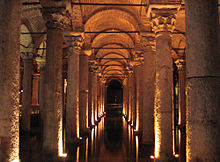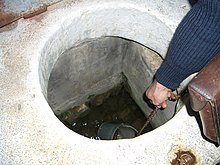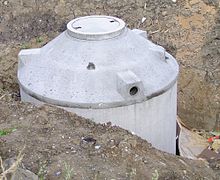cistern
A cistern ( lat. Cisterna for "underground water tank ") is an underground or covered collecting tank for drinking or industrial water .
Application area
In areas with uneven rainfall and hard-to-reach groundwater resources , cisterns are used as buffer tanks for water storage for house systems or small places. They serve to store the precipitation or the surface water . In areas with dry periods and rocky subsoil, the entire water supply depends on them , so that civilization there would not have been possible without the construction of cisterns.
There are traditions with cisterns, for example:
- in the Levant
- in Istanbul and Rome
- on the island of Pantelleria
- in Malta
- in the Balearic Islands (Sitjot)
- Acoma among the North American Pueblo Indians
- in the lagoon old town of Venice
Industrial water cisterns are far more common today than drinking water. Depending on the design, they are also referred to as retention basins . In 2002, around 24,000 mostly open rainwater retention basins were in operation in Germany. In water-rich Central Europe, cistern water is increasingly being used in private homes as service water for washing machines , toilets and garden irrigation , as no treatment is required for these purposes and the quality is sufficient. If the public water supply is inadequate, cisterns can also serve as extinguishing water reservoirs .
Executions
Cisterns have been built in the Mediterranean region for over 7000 years. Often they are made of large blocks of stone and provided with a cap stone or a ceiling construction to prevent soiling. Reaching the changing water level is ensured by stairs or suitable lifting devices .
The historical building materials for cisterns are masonry or concrete . If possible, the cisterns were also cut into the rock. Today, complete, ready-made containers (1.5 to 40 m³) made of plastic ( polyethylene ) or concrete are available. They serve almost exclusively to use rainwater .
In some cases, abandoned, cleaned septic tanks or cleaned oil tanks are used as cisterns for watering the garden.
Water quality
Rainwater is problematic for the drinking water sector: As a rule, this water, mixed with bird droppings, leaves, dust and other impurities, reaches the cistern with little or no pre-treatment. Due to the possible bacterial contamination, it must at least be thoroughly sterilized (e.g. by boiling) before it is suitable for drinking water.
Odor problems must also be expected when used as service water because organic substances in the cistern can go into putrefaction.
When watering the garden, rainwater can be beneficial because rainwater is free of lime .
history

Cisterns were already used in the Stone and Bronze Ages . In the Middle Ages they are often found in hilltop castles , as castle wells are particularly difficult to build due to the great difference in height to the groundwater. The same applies to fortresses in modern times. A distinction must be made between tank cisterns and filter cisterns. A filter cistern was z. B. built on the Riegersburg in Styria, where a cistern was cut into the lava rock . The rainwater was collected in the cistern through sand filters . The rainwater was cleaned by the filters and enriched with minerals. Often cisterns were also built where there was a water pipe leading from outside into the castle or fortress, as this could easily be destroyed by the enemy during a siege .
Outstanding cisterns


One of the most impressive cisterns is Yerebatan Sarnıcı in Istanbul (location for the James Bond film With Love from Moscow ). Next to this is the cistern carved into the rock at the highest point of the old town of Cáceres , the so-called Aljibe of Cáceres, the largest in the world. In 1986 this place in the Spanish Extremadura was declared a UNESCO World Heritage Site. Another well-preserved aljibe is that of Mérida .
The Arabic word “ǧubb” for cistern was adopted as “aljibe” in Spanish. It has retained its importance to this day. Despite the competition of the Latin "cisterna", the word is so vital that it has also been transferred to modern terms such as "camión aljibe" " cistern wagon" . From the Reconquista onwards , when there was a war against the Moors, the word had another meaning, namely "dungeon", "prison". This is due to the fact that thousands of prisoners were locked in underground cisterns, as can still be seen today in an impressive manner in Meknes , Morocco . With the end of hostilities, this word meaning also disappeared. The Uzbek shape of the cistern is the sardoba, which can also be fed by rivers. Malik Sardoba between Samarkand and Bukhara is impressive . On the island of Pantelleria , some Punic cisterns still serve as water reservoirs today. They are connected to each other by a complicated overflow system and have a long oval shape, as is known from Punic settlements. The cistern complex of the Tawila tanks in the Crater district of Aden possibly dates back to the time of the Yemeni Himyarites .
See also
literature
- Heinz Gaube, Sebastian Ristow : Cistern . In: Lexicon of the Middle Ages (LexMA). Volume 9, LexMA-Verlag, Munich 1998, ISBN 3-89659-909-7 , Sp. 629-632.
- Otto Puchstein : Cisterna . In: Paulys Realencyclopadie der classischen Antiquity Science (RE). Volume III, 2, Stuttgart 1899, Col. 2606 f.
- Giovanni Rizzo, Laura Ercoli: The Lining of the Ancient Cisterns in the Volcanic Island of Pantelleria, 515-524.
Web links
Individual evidence
- ↑ a b Natural handling of rainwater. In: Bavarian State Office for the Environment - LfU Bavaria. Bavarian State Office for the Environment (LfU), accessed on April 12, 2020 .
- ↑ Mark Nicolas: What is a cistern? Questions and answers about the cistern. In: water treatment aid. Retrieved April 12, 2020 .
- ↑ Wash laundry with rainwater. In: Ecological building - information on natural building materials and wooden houses. Markus Boos, Gerd Hansen & Hendrik Röhm GbR, accessed on April 12, 2020 .
- ↑ Stephan Reporter: Cistern water as process water. In: Hausjournal.net »Building, Renovating & Living. Retrieved April 12, 2020 .
- ↑ From Russia with Love (1963) - Filming & Production - IMDb. In: IMDb - internet movie data base. Retrieved April 12, 2020 (English).



